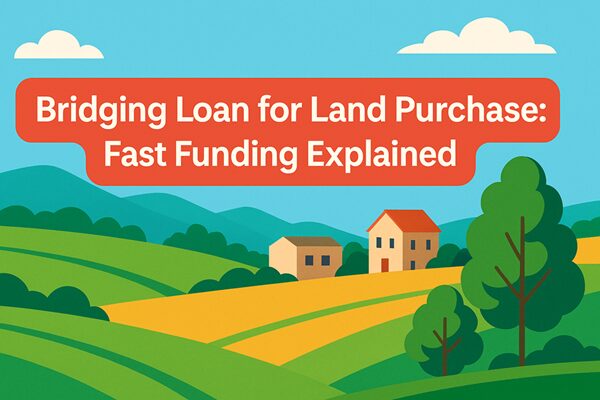Bridging loan land purchase: How it works and when to use it

Purchasing land can be a valuable long-term investment. Whether you plan to build a home, or develop a commercial property, opportunities often arise unexpectedly. When they do, acting quickly is crucial. Many land sales, particularly those at auction or involving high-demand plots, require rapid payment. This is where a bridging loan land purchase can provide the solution you need.
A bridging loan to buy land is a short-term, fast-arranged financial product designed to give you immediate access to funds while you arrange long-term finance or prepare the site for development. It is an increasingly popular option for investors, self-builders, and developers who need speed, flexibility, and certainty in securing a plot.
What is a bridging loan for land purchase?
A bridge loan for land purchases is a temporary loan that helps you complete a purchase quickly when other funding options are too slow. It “bridges” the gap between the moment you need the money and the point when permanent financing becomes available.
Bridging loans on land can be arranged for a range of uses:
- Buying residential plots for self-build projects.
- Acquiring agricultural or rural land.
- Securing commercial development sites.
- Purchasing land that does not yet qualify for a traditional mortgage, such as those without planning permission or with unusual titles.
The approval process for a bridging loan to buy land is usually faster than a standard mortgage, with funds often available within a couple of weeks. This speed is one of the main reasons buyers choose this route.
Benefits of using a bridging loan to buy land
There are several reasons a bridging loan land purchase can be advantageous.
Speed
In competitive markets, speed is everything. Auction purchases, in particular, have strict completion deadlines, often within 28 days. A bridging loan allows you to meet that timeline with minimal delays.
Flexibility
Loan terms can be tailored to suit your project. You can arrange repayment periods from just a few months up to a year or more, depending on your needs and the lender’s terms.
Unlocking potential
If the land requires planning permission or development before it can be refinanced, a bridging loan gives you the breathing space to carry out those steps while retaining ownership.
Common situations in which a bridging loan can be used for land purchases include:
Bridging loans are not just for emergency funding. They are often used strategically in scenarios such as:
- Auction purchases: Many property and land auctions require full payment within a month. Without immediate funds, you risk losing your deposit and the plot itself.
- Development projects: When you plan to build, you must first secure the land before applying for a development mortgage.
- Chain breaks: A bridging loan can keep your land purchase on track if you rely on funds from a property sale that falls through or is delayed.
- Time-sensitive opportunities: Some sellers offer significant discounts for buyers who can complete quickly.
- Unmortgageable land: Plots that lack planning permission, have poor access, or involve legal complexities may not qualify for a standard mortgage.
How the process works
Securing a bridging loan to buy land involves several key steps.
- Initial assessment
You or your broker will provide details of the land, including its location, current use, and value. Lenders will also want to know your intended uses for the land and your exit strategy, how you plan to repay the loan.
- Valuation
A professional valuation is arranged to confirm the market value of the land. This helps the lender determine how much they are willing to lend.
- Loan offer
If the lender is satisfied with the valuation and your repayment plan, they will issue a formal loan offer outlining the terms, interest rate, and fees.
- Completion
Once you accept the offer, legal work is completed and funds are released.
Costs to consider
Bridging loans come with higher interest rates and fees compared to long-term mortgages. Key costs include:
- Interest: Usually charged monthly. Bridging loan rates vary depending on the risk, loan size, and loan-to-value ratio.
- Arrangement fees: A percentage of the loan amount, often 2 percent.
- Legal fees: Payable by both buyer and lender.
- Valuation fees: For professional assessment of the land.
- Exit fees: Some lenders charge this when the loan is repaid.
Factoring in all these costs will help you judge whether a bridging loan land purchase is financially sensible for your project.
Exit strategies for a bridging loan on land
An exit strategy is essential when applying for a bridging loan to buy land. Lenders want to see exactly how you will repay the loan. Common exit strategies include:
- Refinancing: Once planning permission is granted, you refinance to a self-build mortgage or development finance.
- Sale of another asset: Using proceeds from selling a property or other investment.
Comparing bridging loans to other finance options
While bridging loans are useful, they are not the only way to finance a land purchase. Alternative options include:
- Development finance – Longer-term funding designed for construction projects.
- Commercial mortgages – For land already in use.
The right choice depends on your timeline, the nature of the land, and your future plans.
Risks of bridging loans on land
Like any financial product, bridging loans carry risks:
- High interest costs if the project takes longer than planned.
- Potential loss of the land if you cannot repay the loan.
- Market changes: A drop in land values could impact refinancing.
Careful planning and realistic timelines can help manage these risks.
Case study: Using a bridging loan to buy auction land
A developer spots a prime plot at auction with a guide price of £150,000. They have a plan to build three houses, but their development finance is not yet approved. The auction requires payment within 28 days.
The developer secures a bridging loan covering 55 percent of the purchase price. Within a couple of weeks, the funds are released, the land is secured, and planning permission is applied for. Six months later, once permission is granted, they refinance onto a development loan and repay the bridging lender in full.
This scenario demonstrates how bridging finance can unlock opportunities that would otherwise be missed.
FAQ: Bridging loan land purchase
Can I get a bridging loan without planning permission?
Yes, many lenders provide bridging loans on land without planning permission, though interest rates may be higher and the maximum loan to value offered may be lower.
What is the maximum term for a bridging loan to buy land?
Terms typically range from three to twelve months, but some lenders offer up to two years.
How quickly can I get funds?
Some bridging loans can be completed in as little as 1 week, depending on the complexity of the transaction.
Do I need a deposit?
Yes, most lenders require you to contribute a percentage of the purchase price, often around 45 to 50 percent where there is no planning permission in place. If planning permission is already in place then a lower deposit of 30 to 40 percent is required.
Can I use a bridging loan for agricultural land?
Yes, bridging loans are available for various types of land, including agricultural, provided you meet the lender’s criteria.
Conclusion
A bridging loan land purchase is an effective way to secure plots quickly when traditional finance cannot move fast enough. Whether you are buying at auction, investing in development opportunities, or securing a rare plot, bridging loans on land provide the speed and flexibility to act decisively.
By understanding the process, costs, and risks, and by working with a reputable lender or broker, you can make the most of this powerful funding option. With careful planning and a clear exit strategy, a bridging loan to buy land can turn an opportunity into a successful investment.




